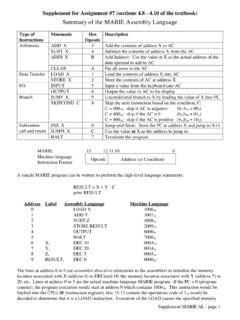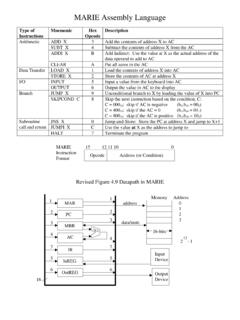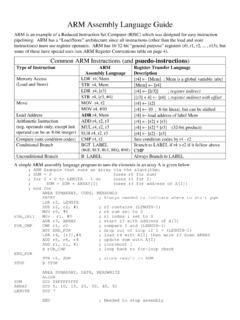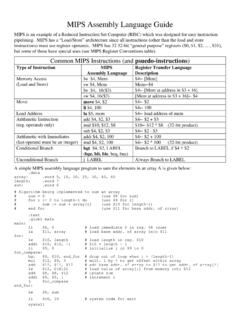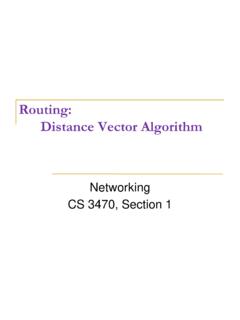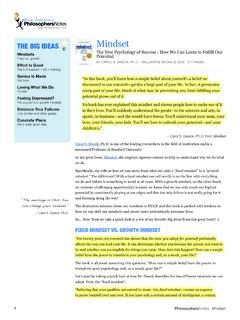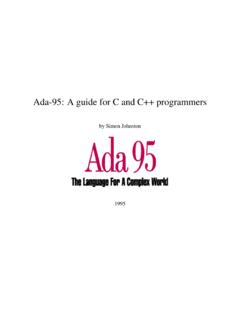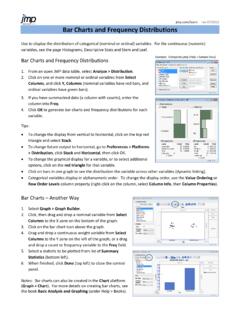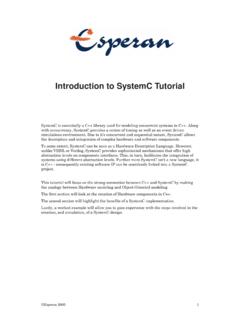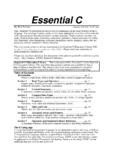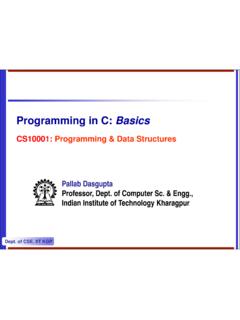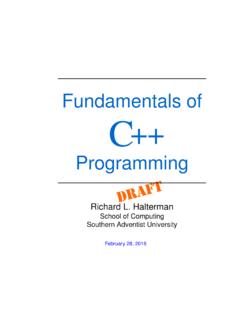Transcription of Introduction to the Mumps Language
1 Introduction to the Mumps LanguageA Quick Introduction to theMumps Programming LanguageKevin C. O'KaneProfessor EmeritusDepartment of Computer ScienceUniversity of Northern IowaCedar Falls, IA full text on this topic in both print and ebook formats is available on are available on : of the software used in this tutorial are are available at: ~okane/ 4, 2017 Mumps History 1 Mumps (Massachusetts General Hospital Utility Multi-programming System) is a general purpose programming Language environment that provides ACID (Atomic, Consistent, Isolated, and Durable) database access by means of program level subscripted arrays and variables. The Mumps database allows schema-less, key-value access to disk resident data organized as trees that may also be viewed as sparse multi-dimensional in 1966, Mumps (also referred to as M), was developed by Neil Pappalardo and others in Octo Barnett's lab at the Massachusetts General Hospital (MGH) on a PDP-7, the same architecture on which Unix was being implemented at approximately the same time.
2 Initial experience with Mumps was very positive and it soon was ported to a number of other architectures including the PDP-11, the VAX, Data General, Prime, and, eventually, Intel x86 based systems, among others. It quickly became the basis for many early applications of computers to the health sciences. Mumps History 2 When Mumps was originally designed, there were very few general purpose database systems in existence. The origin of the term 'database' itself dates from this period. Such systems as existed, were mainly ad hoc application specific implementations that were neither portable nor extensible. The notion of a general purpose database design was just of the first attempts to implement of a general purpose database system was GE/Honeywell's initial IDS - Integrated Data Store - which was developed in the mid-60s.
3 Experience with this system lead to the subsequent creation of the CODASYL DBTG (Committee on Data Systems Languages - Data Base Task Group) whose Network Model database was proposed (1969).The Network Model was very complex and was implemented, in varying degrees, by only a few vendors. All of these were mainframe based. Most notable of these were GE/Honeywell's IDS/2, Cullinet's Integrated Database Management System (IDMS), Univac's DMS-1100, and Digital Equipment Corporation's DEC-10 based DBMS32. Mumps History 3At about the same time, IBM's IMS (Information Management System), was being developed in connection with the NASA Apollo program. It was first placed into service in 1968 running on IBM 360 mainframes. IMS, which is still in use today, is, like Mumps , a hierarchically structured database.
4 The table-based relational database model was initially proposed by E. F. Codd in 1970 but it wasn't until 1974 that IBM began to develop System R, the first system to utilize the model, as a research project. The first commercially available relational database system was released by Oracle in 1979. Mumps History 4In late 1960s mini-computers, although expensive, were becoming more widely available but they were still mainly confined to dedicated, mostly laboratory, applications. The operating systems available on these systems were primitive and, for the most part, single user. On many, the user was the operating system, flipping switches to install boot code, and manually loading compilers, linkers and programs from paper or magnetic 's RSX-11, the first commercial multi-user system on the PDP-11, was introduced in 1972.
5 RSTS/E, a time sharing system mainly used for BASIC Language programming, was implemented in 1970. Other Language support was limited to a small set of languages such as FORTRAN, BASIC and Assembly Language . Although Unix existed at this time, it was not available outside AT&T until , in 1966 when a DEC PDP-7 arrived at the Massachusetts General Hospital (MGH), there was very little in the way of software, operating system or database support available for it. So, as there were few other options available, people at MGH started from scratch and designed Mumps to be not only a multi-user operating system, but also a Language , and a database, all in one. Mumps History 5 For their database design, they selected a hierarchical model as this closely matched the tree structured nature of the medical record.
6 To represent database trees in the Language , they decided to use array references where each successive array index was part of a path description from the root of the array to both intermediate and terminal nodes. They called these disk resident structures global in those days, Mumps , out of necessity, was its own standalone operating system, this is not the case today where Mumps programs run in Unix, Linux, OS/X, and Windows based early Mumps operating system divided the very limited memory available on early mini-computers into small partitions, each assigned to a separate user. The system allocated and managed the memory partitions and granted time-slices to each user partition usually in a round-robin protocol. The Mumps operating system itself provided the Mumps Language interpreter ( Mumps was not compiled), centralized I/O, and managed access to the hierarchical database through a centralized Global Array File Manager, as outlined in the following figure.
7 Mumps History 6 Mumps History 7 Memory on early mini-computers was limited, sometimes only a few thousand characters. Mumps programs were loaded into memory as source code rather than as compiled binary. This was done because it was determined that compiled Mumps programs would be far larger than the corresponding source code versions, especially if the source code employed size reducing abbreviations. While interpreted programs ran slower, the time lost was more than made up by the time saved by not needing to page in and out large binary modules which, initially, was done from magnetic tape. Further, as is the case with most database applications, most program time is spent waiting for database access so the interpretation overhead factor was not really very an added benefit, small source code modules used less disk space which, when it became available, was very expensive.
8 Mumps History 8 The legacy of small memory machines can still be seen to this day, as Mumps programmers tend to abbreviate their code, sometimes excessively, although the original reason for doing so is long of its simplicity, low cost, and ease of use, Mumps quickly became popular and was used in many medical applications. COSTAR (COmputer-STored Ambulatory Record), for example, was a medical record, fiscal management and reporting system, developed in the mid-1970s for use in ambulatory care settings and it was widely used and adapted worldwide. Mumps History 9 Today, Mumps programs are employed extensively in financial and clinical applications. If you've been to a doctor, been seen at a hospital, or used an ATM machine, your data has probably been processed by a Mumps programs are the basis of the Veterans Administration's computerized medical record system VistA (Veterans Health Information Systems and Technology Architecture), the largest of its kind in the world.
9 VistA is a collection of 80 different software subsystems that support the largest medical records system in the United States. It supports the medical records of over 8 million veterans, is used by 180,000 medical staff at 163 hospitals, more than 800 clinics, and 135 nursing is used by many health care organizations including Allscripts, Epic, Coventry Healthcare, EMIS, Partners HealthCare (including Massachusetts General Hospital), MEDITECH, GE Healthcare (formerly IDX Systems and Centricity), Sunquest Information Systems, DASA, Quest Diagnostics, and Dynacare, among others. Mumps History 10 Some of the largest and most well known hospitals use Mumps based electronic health records systems. These include: Kaiser Permanente, Cleveland Clinic, Johns Hopkins Medicine Hospitals, UCLA Health, Texas Health Resources, Massachusetts General Hospital, Mount Sinai Health System in New York City and the Duke University Health System.
10 Among financial, institutions it is used by Ameritrade, the Bank of England and Barclays Bank, as well as others. Mumps History 11 Mumps has remained viable by providing: In addition to sequential and direct file access, Mumps also implements, as an integral part of the Language , a hierarchical and multi-dimensional database paradigm. When viewed as trees, data nodes can addressed as path descriptions in a manner which is easy for a novice programmer to master in a relatively short time. Alternatively, the trees can be viewed as sparse n-dimensional matrices of effectively unlimited size. Mumps supports built-in string manipulation operators and functions that provide programmers with access to efficient methods to accomplish complex string manipulation and pattern matching operations.
